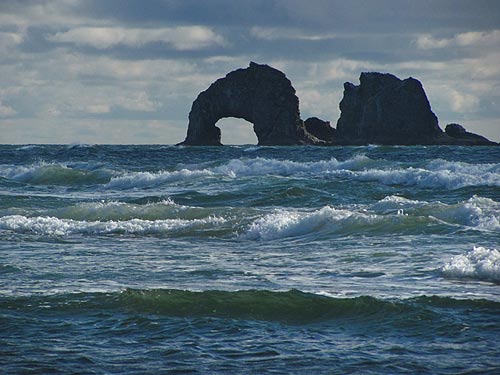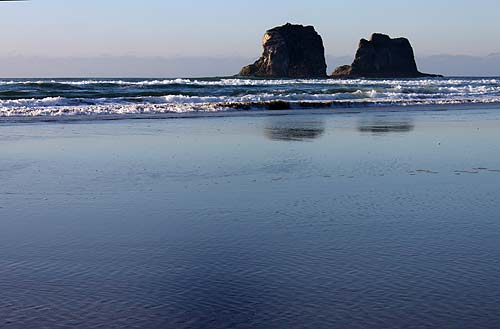More Beneath Sands of Oregon Coast Town Than Meets the Eye, Rockaway Beach History
Published 01/07/2011
 |
| Photo of the pilings from the natatorium courtesy Seaside Aquarium |
(Rockaway Beach, Oregon) - The north Oregon coast town has recently become rather famous for the shipwreck that has briefly peeked out of the sands, but there’s even more buried here. Now, as the sand levels appear to be quickly covering the wreck of the Emily G. Reed back up, there are still more treasures to hunt for.
Currently, there is another wooden structure sticking up out of the sand at Rockaway, one that is getting confused as being part of the now-famous shipwreck.
Somewhere in the early part of the century, as Rockaway Beach got its start, the town acquired a natatorium – a heated salt water pool, the kind that was all the rage before the 1940’s. Newport’s Nye Beach had one, Seaside had two, and a now-swallowed up ghost town called Bayocean – on the Tillamook Bay – also had one.
The one at Bayocean had something in common with the one at Rockaway Beach: both were pitted against nature. Bayocean lost that fight entirely, and the almost the whole resort town was swallowed by the sea eventually. The one at Rockaway Beach fought a stream rather than the ocean itself, so its extinction wasn’t quite as dramatic.

The natatorium at Rockaway in 1928 - courtesy Don Best
“When they built the natatorium in Rockaway Beach, where the wayside is today, they also built a bulkheaded channel for the creek - Rock Creek,” said Don Best, a resident and local historian. “It was about three feet wide and 8 to 10 feet tall, with 2 x 12 inch planking on the sides and even a covered top so that the creek would not ‘wander’ back and forth with the seasons.”
Right now there’s a small, circular wood structure, comprised of what look like little pilings jutting up from the sand, located close to the main wayside in Rockaway Beach and the big creek that comes spilling out from that area.
 |
| The wreck of the Emily G. Reed, as seen in December, but it's quickly disappearing now. |
“This is the remains of that bulkhead used to channel the creek,” Best said. “Several creeks had this type of structure made: Rock Creek, the creek coming out of Spring lake, to name a few. As a kid I remember playing out at the end of the bulkheaded channel where the water came out.”
Best points out that there were actually two lengths of the bulkhead, a shorter version and a longer one. The shorter one is visible in the 1928 aerial photo.
The photo taken by Seaside Aquarium staff shows a remnant of the longer version of the structure.
“The short version is very close to the rip-rap that is now at the edge of the wayside,” Best said.
 |
| Pilings from the bulkhead confused even BeachConnection.net and they mislabeled as "ghost forest" stumps. |
These little points of wood have been confusing in more ways than just the shipwreck. Oregon Coast Beach Connection incorrectly identified these as some of the “ghost forest” stumps that are visible along the Oregon coast at certain spots during winter low sand level events. It turns out, they are much younger than the 2000 to 4000 years in age of those odd structures – and these are manmade.
Beneath the sands of Rockaway, another chunk of the Reed shipwreck has been seen periodically, but much rarer than this large chunk that is disappearing.
Another section of the Reed is visible all the time, but it is lodged in a riverbank, a ways upstream in Nedonna Creek, at the northern end of Rockaway Beach. Manzanita Hotels in this area - Where to eat - Maps and Virtual Tours


Rockaway Beach and its Twin Rocks.
More About Manzanita, Rockaway, Wheeler Lodging.....
More About Oregon Coast Restaurants, Dining.....
LATEST Related Oregon Coast Articles
One was a rare orca find; both suspected human interaction. Marine sciences
N. Oregon Coast's 'Cheese War' a Quiet Part of Tillamook-Area History: See th...
History talk in Nehalem on April 26 about Tillamook battles. Manzanita events, Cannon Beach events, Tillamook events
Lyrid Meteors with a Possible Side of Aurora for Washington, Oregon, Coastlines
Lyrids peak on Monday, northern lights possible northern Washington. Weather
Road Work Coming to North Oregon Coast's Gearhart and One of World's Largest ...
Lane closures this summer on the bridge; major work in Gearhart next year. Washington coast
Be Jeweled Returns to Central Oregon Coast, Newport's Dazzling, Arty Jewelry ...
Saturday, May 10, from 10 AM to 4 PM featuring more than 2,000 pieces. Newport events
N. Oregon Coast Bridge Work During Travel Season: Some Traffic Delays on Asto...
Occasional one-lane traffic from June through September at Astoria / Ilwaco. Washington coast
Cape Kiwanda's Colossal Sand Dune: Wild Oregon Coast Rides and How It's Changing
A mix of crazy recreation with science of a crumbling landmark. Sciences, Pacific City, Oceanside
Oregon Coast, Valley and Likely Washington Coast to Get Some Aurora Borealis ...
Likely just before dawn best hour but peak happens during daylight. Weather
Back to Oregon Coast
Contact Advertise on BeachConnection.net
All Content, unless otherwise attributed, copyright BeachConnection.net Unauthorized use or publication is not permitted











































